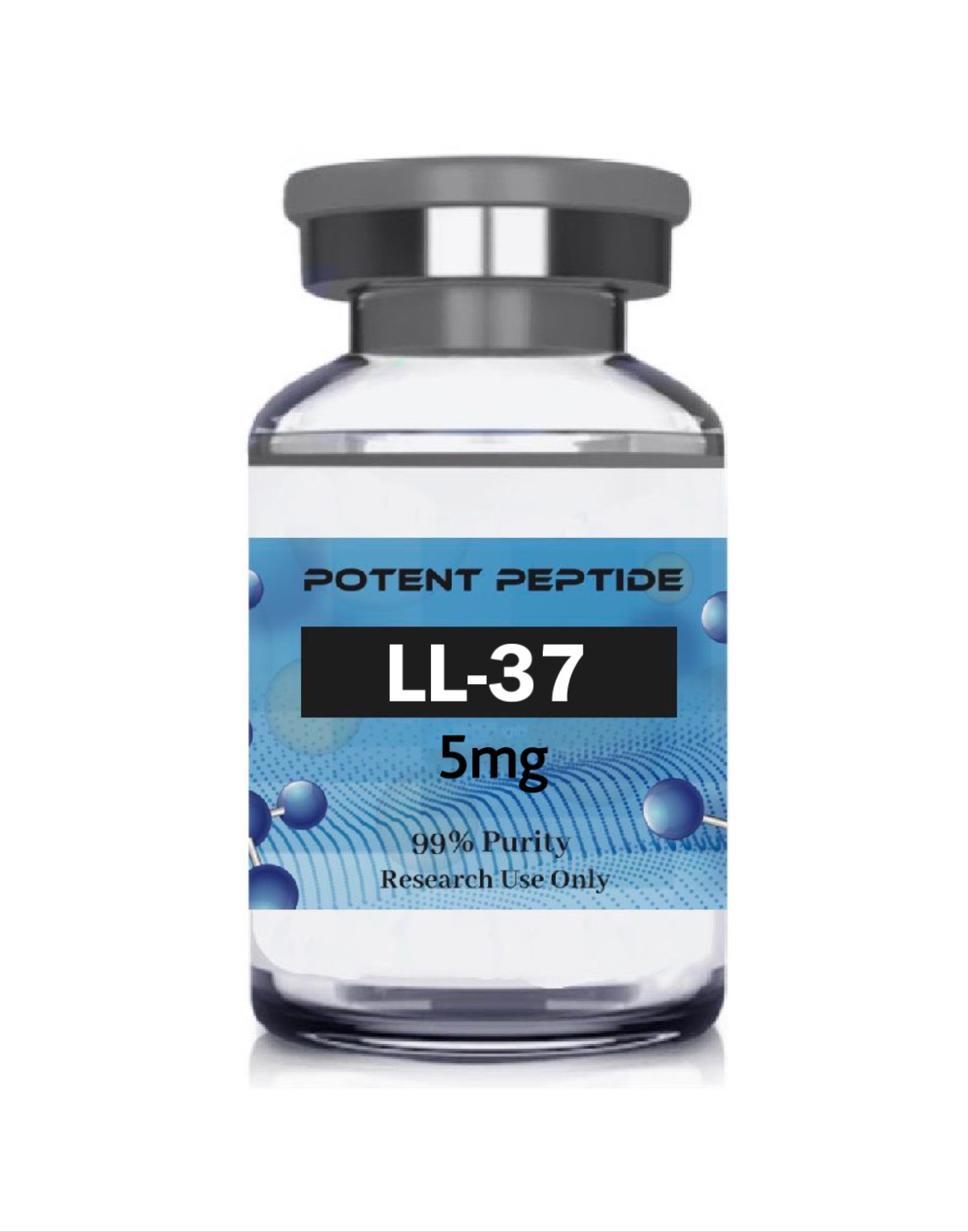Description
LL-37 Peptide
LL-37 is a Cathelicidin, a protein family where the members exhibit diverse functions. These peptides, which are produced by macrophages and polymorphonuclear leukocytes (both types of white blood cells), have been suggested to exhibit bactericidal action. They have been suggested to have shown other substantial potential impacts as well. The entire group is classified as antimicrobial peptides (AMPs). LL-37, in particular, has been researched in relation to autoimmune disease, cancer, and wound healing.[1] For example, researchers note that “Corneal and conjunctival epithelia express LL-37 as part of mucosal innate immunity to protect against bacterial and viral ocular infections.”
Specifications
OTHER KNOWN TITLES: CAP-18
MOLECULAR FORMULA: C205H340N60O53
MOLECULAR WEIGHT: 4493.33 g/mol
SEQUENCE: Leu-Leu-Gly-Asp-Phe-Phe-Arg-Lys-Ser-Lys-GluLys-Ile-Gly-Lys-Glu-Phe-Lys-Arg-Ile-Val-Gln-Arg-Ile-Lys-Asp-Phe-Leu-Arg-Asn-Leu-Val-Pro-ArgThr-Glu-Ser
LL-37 Peptide Research
LL-37 AND INFLAMMATORY DISEASES
LL-37, although essentially researched as an antimicrobial peptide, has also been examined in research related to different inflammatory diseases such as lupus, rheumatoid arthritis, psoriasis, and atherosclerosis. LL-37 researchers suggest the peptide’s diverse immune system modulating behaviors based on the type of cells involved and the local inflammatory environment. It has been suggested to reduce apoptotic death of keratinocytes, improve IFN-alpha synthesis, suppress signaling through toll-like receptor 4 (TLR4), modify chemotaxis of neutrophils and eosinophils,[2] trigger IL-18 production and potentially reduce levels of atherosclerotic plaques. Interestingly, LL-37 (aka CAP-18) appears to stimulate the immune system in a different manner depending on the trigger. Cell culture studies have observed the importance of the inflammatory environment in determining the immune response to LL-37. T-cells appear to improve inflammatory action via LL-37 when they are not activated, but minimize the inflammatory action when already activated. The peptide appears to mediate homeostasis of immunological response, thus controlling it from being hyperactive in instances of infection. There is a strong correlation between the peptide levels and the extent of the disease. Initially, LL-37 / CAP-18 was thought to promote autoimmune disorders, but recent results have suggested it may actually help to abate the damage.[3] The researchers outline that the peptide has a role in “in the modulation of immune and inflammatory pathways and their effects on autoimmune and inflammatory diseases.” High levels of the peptide may thus help check further increased inflammation.
LL-37 AND ANTIMICROBIAL CHARACTERISTICS
LL-37 appears to be an important biomolecule of innate immunity and one of the initial proteins to activate when faced with an infection. Research findings in skin infection studies suggests that the peptide, though present in limited skin cells, appears to accumulate very fast when invading pathogens are present.[4] It may work in conjunction with other proteins, like beta-defensin 2, to potentially fight infection. LL-37 appears to bind to bacterial lipopolysaccharide (LPS) of the outer membrane of gram-negative bacteria. LPS is considered critical for the membrane integrity of these bacteria. The possible action of LL-37 to bind to and interfere with LPS may make it toxic for certain bacteria. LL-37 may exert action against gram-positive pathogens, as suggested in research in staph infections and other serious bacteria. Research indicates that LL-37 / CAP-18 may improve lysozyme’s action, which destroys gram-positive bacteria like Staph aureus.
LL-37 AND LUNG DISEASE
LPS is found in several different organisms and, in some instances, may become airborne when an environment is contaminated by mold or other fungi. Normal lung tissue responds by producing mucus upon LPS inhalation. Unfortunately, the response is often insufficient to intercept toxic dust syndrome and respiratory diseases like asthma and COPD. LL-37 has been studied in research of toxic dust syndrome.[5] LL-37 appears to promote the proliferation of epithelial cells and the closure of wounds in lung diseases. The peptide may attract airway epithelial cells to injury sites and help vascularization, wound healing, and supply of nutrition to the newly formed tissue.
LL-37 PEPTIDE AND ARTHRITIS
Research in rats models observed high LL-37 levels in joints of rat models of rheumatoid arthritis. It is yet unknown if is the cause or cure for the condition. However, several findings indicate the potential of the peptide in inflammation. LL-37 deficiency does not appear to change the outcomes in animal models of arthritis or lupus.[6] Animals expressing the peptide may show the same disease outcome as those lacking the peptide. These results indicate that the physiological reactions in enhanced levels of cathelicidins in arthritis are incidental. Peptides derived from LL-37 may reduce collagen damage which occurs in inflammatory arthritis. Direct introduction of these peptides to arthritic joints in rats was observed to reduce both the severity of the disease as well as serum levels of antibodies against type II collagen. Direct involvement of interleukin-32 (IL-32) in the severity of inflammatory arthritis has been reported. LL-37 and its derivatives may have the ability to regulate the level of IL-32 response. Researchers consider that it would be reasonable to speculate that the peptide is protective in this disease scenario. Synovial fluid fibroblasts increase toll-like receptor 3 levels, with scientists consider worsens the arthritic condition by increasing inflammatory cytokine expression. LL-37 may interact with TLR4 and either promote pro-inflammatory or anti-inflammatory outcomes.[7] It is yet to be confirmed if LL-37 / CAP-18 mediates the same effect against the backdrop of increased TLR3. The peptide has been examined in experimental studies to selectively decrease pro-inflammatory macrophage responses, and researchers suggest its regulation of inflammation to be selective.
LL-37 AND INTESTINAL CANCER
Cell culture-based research studies have suggested potential multifaceted functions of LL-37 in the intestine. The peptide appears to improve the migration of cells necessary for epithelial barrier maintenance of the intestine. LL-37 may reduce apoptosis when there is intestinal inflammation, helping to decline the causes of inflammation and the associated pathogenesis. Studies suggest LL-37 pairs with beta-defensin 2 to help in wound healing. Research indicates that the peptides work simultaneously to repair and maintain the intestinal epithelium while decreasing TNF-related cell death.[8] Despite being the principal compounds researched in inflammatory bowel conditions, TNF-alpha inhibitors have been reported to exhibit adverse ancillary impacts. LL-37-exposure may potentially reduce the dependence on TNF-alpha inhibitors. Research in the peptide action on cancer cells has generated mixed reports.
LL-37 AND BLOOD VESSEL GROWTH
The peptide appears to produce prostaglandin E2 (PGE2) in endothelial cells. In endothelial cells, PGE2 promotes the development of blood vessels via a process called angiogenesis. It is crucial to regulate angiogenesis as it impacts cancer development, stroke outcomes, heart disease, wound healing, and more. LL-37 helps to study angiogenesis in-depth to promote it in cardiac disease and discourage cancer milieu.
Disclaimer: The products mentioned are not intended for human or animal consumption. Research chemicals are intended solely for laboratory experimentation and/or in-vitro testing. Bodily introduction of any sort is strictly prohibited by law. All purchases are limited to licensed researchers and/or qualified professionals. All information shared in this article is for educational purposes only.
References
- Gordon YJ, Huang LC, Romanowski EG, Yates KA, Proske RJ, McDermott AM. Human cathelicidin (LL-37), a multifunctional peptide, is expressed by ocular surface epithelia and has potent antibacterial and antiviral activity. Curr Eye Res. 2005 May;30(5):385-94. doi: 10.1080/02713680590934111. PMID: 16020269; PMCID: PMC1497871.
- Alalwani SM, Sierigk J, Herr C, Pinkenburg O, Gallo R, Vogelmeier C, Bals R. The antimicrobial peptide LL-37 modulates the inflammatory and host defense response of human neutrophils. Eur J Immunol. 2010 Apr;40(4):1118-26. doi: 10.1002/eji.200939275. PMID: 20140902; PMCID: PMC2908514.
- Kahlenberg JM, Kaplan MJ. Little peptide, big effects: the role of LL-37 in inflammation and autoimmune disease. J Immunol. 2013 Nov 15;191(10):4895-901. doi: 10.4049/jimmunol.1302005. PMID: 24185823; PMCID: PMC3836506.
- Reinholz M, Ruzicka T, Schauber J. Cathelicidin LL-37: an antimicrobial peptide with a role in inflammatory skin disease. Ann Dermatol. 2012 May;24(2):126-35. doi: 10.5021/ad.2012.24.2.126. Epub 2012 Apr 26. PMID: 22577261; PMCID: PMC3346901.
- Golec M. Cathelicidin LL-37: LPS-neutralizing, pleiotropic peptide. Ann Agric Environ Med. 2007;14(1):1-4. PMID: 17655171.
- Moreno-Angarita A, Aragón CC, Tobón GJ. Cathelicidin LL-37: A new important molecule in the pathophysiology of systemic lupus erythematosus. J Transl Autoimmun. 2019 Dec 17;3:100029. doi: 10.1016/j.jtauto.2019.100029. PMID: 32743514; PMCID: PMC7388365.
- Singh D, Vaughan R, Kao CC. LL-37 peptide enhancement of signal transduction by Toll-like receptor 3 is regulated by pH: identification of a peptide antagonist of LL-37. J Biol Chem. 2014 Oct 3;289(40):27614-24. doi: 10.1074/jbc.M114.582973. Epub 2014 Aug 4. PMID: 25092290; PMCID: PMC4183800.
- Piktel E, Niemirowicz K, Wnorowska U, Wątek M, Wollny T, Głuszek K, Góźdź S, Levental I, Bucki R. The Role of Cathelicidin LL-37 in Cancer Development. Arch Immunol Ther Exp (Warsz). 2016 Feb;64(1):33-46. doi: 10.1007/s00005-015-0359-5. Epub 2015 Sep 22. PMID: 26395996; PMCID: PMC4713713.


Reviews
There are no reviews yet.